Environmental Sustainability and Low/Zero Carbon Emissions Analysis
VerifiedAdded on 2023/06/03
|10
|2405
|222
Report
AI Summary
This report delves into the critical aspects of environmental sustainability concerning carbon emissions, particularly within the building and construction sector. It examines various strategies for achieving low or zero carbon emissions, including the selection of sustainable construction materials, innovative construction processes, and the implementation of renewable energy systems. The report emphasizes the importance of minimizing climate change impacts, improving health outcomes, and reducing environmental pollution through sustainable building practices. It further explores the feasibility and challenges associated with implementing redesigned homes with low/zero carbon emissions, addressing issues such as transitioning from strategic plans to operational actions, setting up effective performance indicators, and overcoming challenges related to documentation and policy. The report also highlights the significance of recycling and reusing materials to reduce carbon footprints and promote environmental sustainability in construction management. Access more solved assignments and past papers on Desklib.
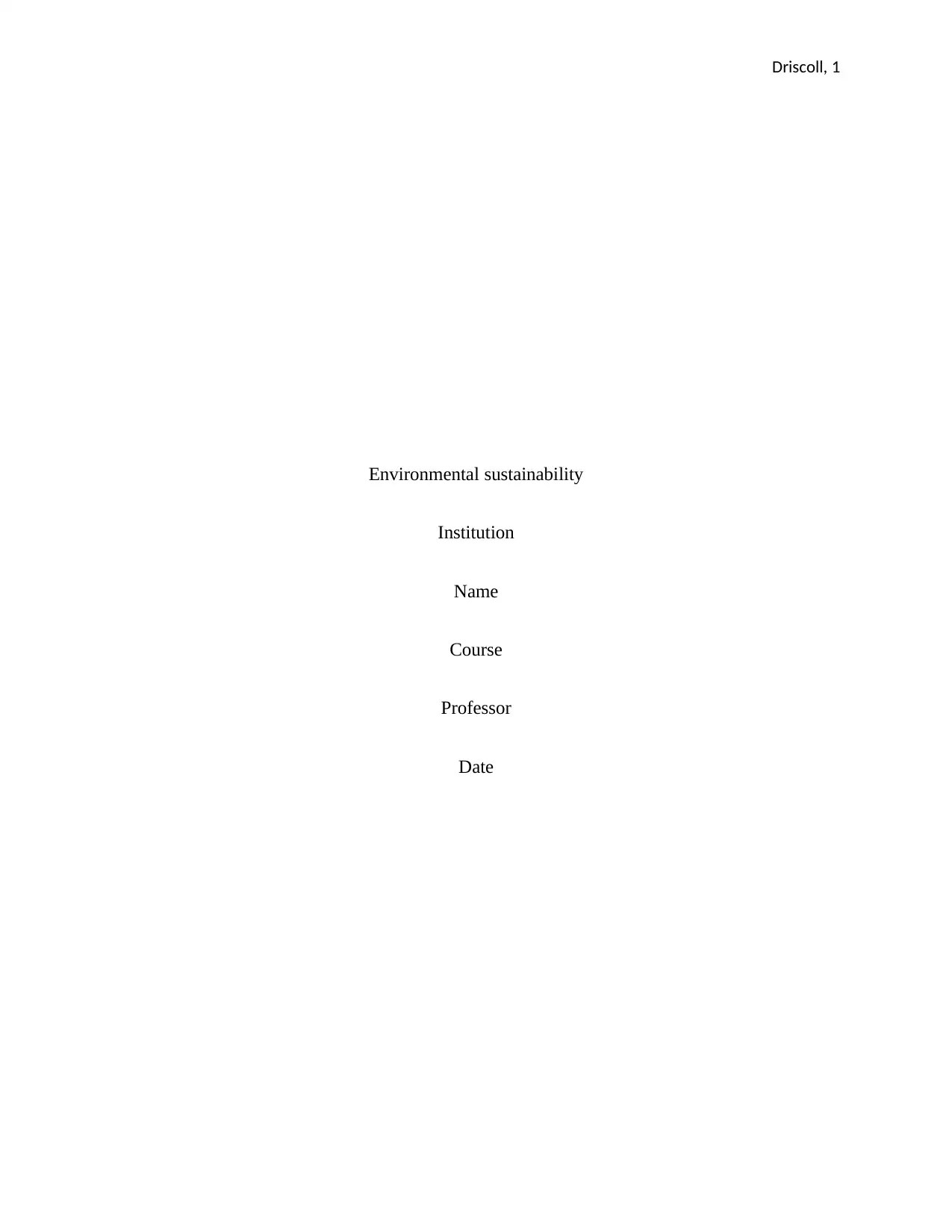
Driscoll, 1
Environmental sustainability
Institution
Name
Course
Professor
Date
Environmental sustainability
Institution
Name
Course
Professor
Date
Paraphrase This Document
Need a fresh take? Get an instant paraphrase of this document with our AI Paraphraser
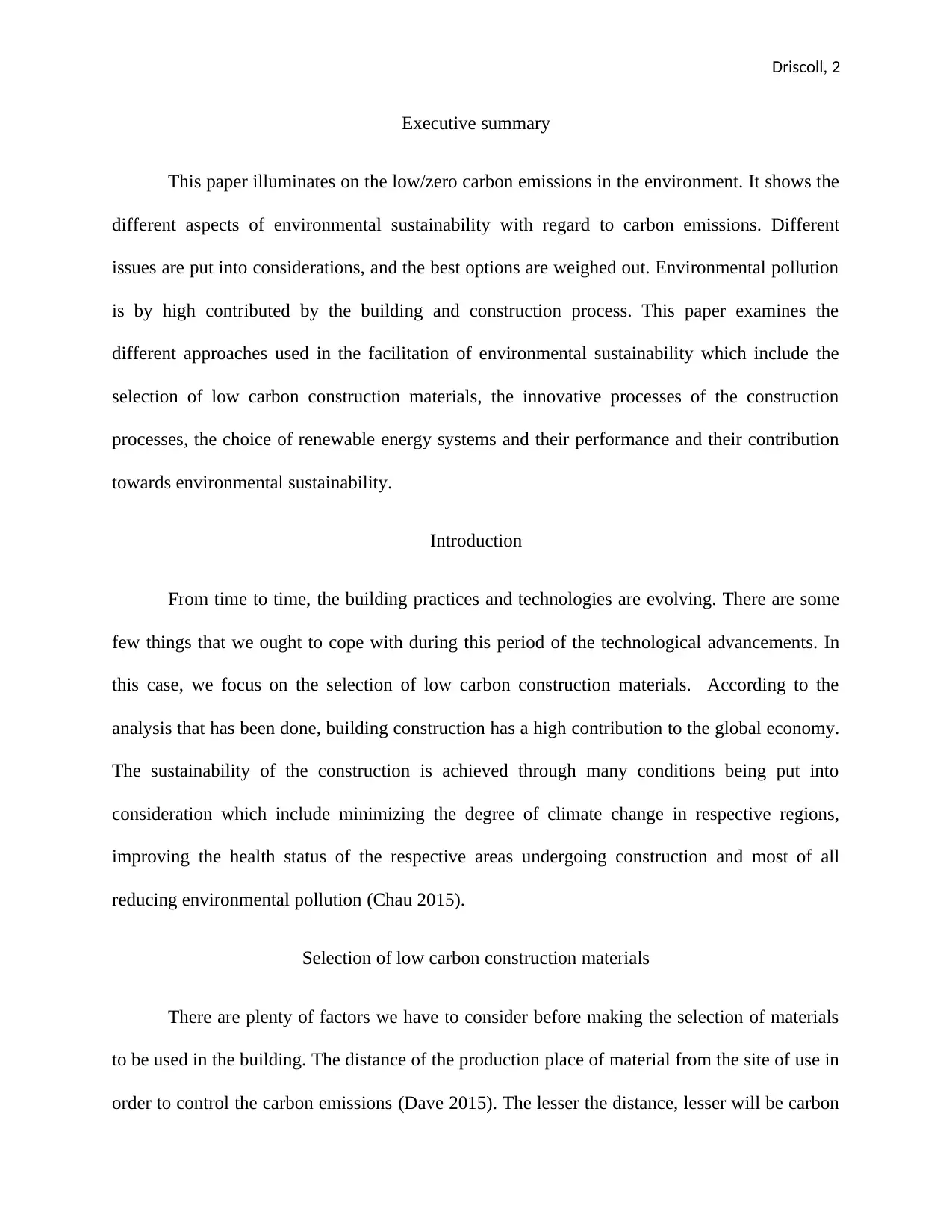
Driscoll, 2
Executive summary
This paper illuminates on the low/zero carbon emissions in the environment. It shows the
different aspects of environmental sustainability with regard to carbon emissions. Different
issues are put into considerations, and the best options are weighed out. Environmental pollution
is by high contributed by the building and construction process. This paper examines the
different approaches used in the facilitation of environmental sustainability which include the
selection of low carbon construction materials, the innovative processes of the construction
processes, the choice of renewable energy systems and their performance and their contribution
towards environmental sustainability.
Introduction
From time to time, the building practices and technologies are evolving. There are some
few things that we ought to cope with during this period of the technological advancements. In
this case, we focus on the selection of low carbon construction materials. According to the
analysis that has been done, building construction has a high contribution to the global economy.
The sustainability of the construction is achieved through many conditions being put into
consideration which include minimizing the degree of climate change in respective regions,
improving the health status of the respective areas undergoing construction and most of all
reducing environmental pollution (Chau 2015).
Selection of low carbon construction materials
There are plenty of factors we have to consider before making the selection of materials
to be used in the building. The distance of the production place of material from the site of use in
order to control the carbon emissions (Dave 2015). The lesser the distance, lesser will be carbon
Executive summary
This paper illuminates on the low/zero carbon emissions in the environment. It shows the
different aspects of environmental sustainability with regard to carbon emissions. Different
issues are put into considerations, and the best options are weighed out. Environmental pollution
is by high contributed by the building and construction process. This paper examines the
different approaches used in the facilitation of environmental sustainability which include the
selection of low carbon construction materials, the innovative processes of the construction
processes, the choice of renewable energy systems and their performance and their contribution
towards environmental sustainability.
Introduction
From time to time, the building practices and technologies are evolving. There are some
few things that we ought to cope with during this period of the technological advancements. In
this case, we focus on the selection of low carbon construction materials. According to the
analysis that has been done, building construction has a high contribution to the global economy.
The sustainability of the construction is achieved through many conditions being put into
consideration which include minimizing the degree of climate change in respective regions,
improving the health status of the respective areas undergoing construction and most of all
reducing environmental pollution (Chau 2015).
Selection of low carbon construction materials
There are plenty of factors we have to consider before making the selection of materials
to be used in the building. The distance of the production place of material from the site of use in
order to control the carbon emissions (Dave 2015). The lesser the distance, lesser will be carbon
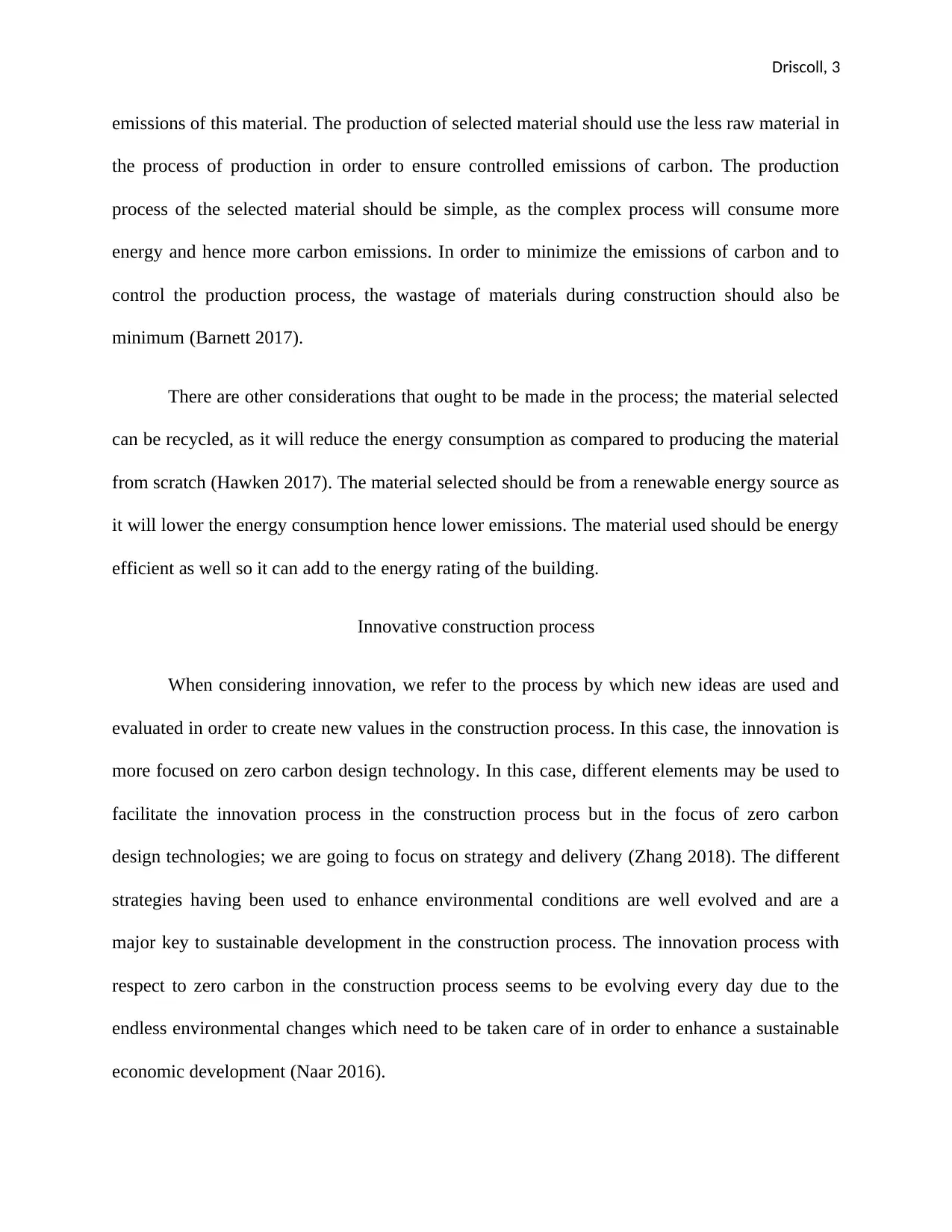
Driscoll, 3
emissions of this material. The production of selected material should use the less raw material in
the process of production in order to ensure controlled emissions of carbon. The production
process of the selected material should be simple, as the complex process will consume more
energy and hence more carbon emissions. In order to minimize the emissions of carbon and to
control the production process, the wastage of materials during construction should also be
minimum (Barnett 2017).
There are other considerations that ought to be made in the process; the material selected
can be recycled, as it will reduce the energy consumption as compared to producing the material
from scratch (Hawken 2017). The material selected should be from a renewable energy source as
it will lower the energy consumption hence lower emissions. The material used should be energy
efficient as well so it can add to the energy rating of the building.
Innovative construction process
When considering innovation, we refer to the process by which new ideas are used and
evaluated in order to create new values in the construction process. In this case, the innovation is
more focused on zero carbon design technology. In this case, different elements may be used to
facilitate the innovation process in the construction process but in the focus of zero carbon
design technologies; we are going to focus on strategy and delivery (Zhang 2018). The different
strategies having been used to enhance environmental conditions are well evolved and are a
major key to sustainable development in the construction process. The innovation process with
respect to zero carbon in the construction process seems to be evolving every day due to the
endless environmental changes which need to be taken care of in order to enhance a sustainable
economic development (Naar 2016).
emissions of this material. The production of selected material should use the less raw material in
the process of production in order to ensure controlled emissions of carbon. The production
process of the selected material should be simple, as the complex process will consume more
energy and hence more carbon emissions. In order to minimize the emissions of carbon and to
control the production process, the wastage of materials during construction should also be
minimum (Barnett 2017).
There are other considerations that ought to be made in the process; the material selected
can be recycled, as it will reduce the energy consumption as compared to producing the material
from scratch (Hawken 2017). The material selected should be from a renewable energy source as
it will lower the energy consumption hence lower emissions. The material used should be energy
efficient as well so it can add to the energy rating of the building.
Innovative construction process
When considering innovation, we refer to the process by which new ideas are used and
evaluated in order to create new values in the construction process. In this case, the innovation is
more focused on zero carbon design technology. In this case, different elements may be used to
facilitate the innovation process in the construction process but in the focus of zero carbon
design technologies; we are going to focus on strategy and delivery (Zhang 2018). The different
strategies having been used to enhance environmental conditions are well evolved and are a
major key to sustainable development in the construction process. The innovation process with
respect to zero carbon in the construction process seems to be evolving every day due to the
endless environmental changes which need to be taken care of in order to enhance a sustainable
economic development (Naar 2016).
⊘ This is a preview!⊘
Do you want full access?
Subscribe today to unlock all pages.

Trusted by 1+ million students worldwide

Driscoll, 4
Innovation takes new and different impacts on the construction process. The zero carbon
design technology is one that serves to the advantage of the global economy in terms of the
reduced costs in the construction industry. This is because many construction materials that are
carbon-free are made from the process of recycling (Naar 2016).
Management of operative energy consumption and consumption behavior
During construction, the operative energy that is consumed when using zero carbon
construction material is less as compared to other materials. This is because the zero carbon
materials have already undergone part of the process and the fact that the emissions associated
with the construction with carbon materials are too much in the environmental pollution (Zhou
2015). The energy consumption in the process of construction is quite impressive when it comes
to using zero carbon materials in the process of construction. The presence of carbon in the
construction materials makes the process of combustion difficult and also long. The breakdown
of carbon results in the high consumption energy in the process thus making the use of zero
carbon materials in the construction process more economical (Atmaca 2015).
Choice of renewable energy systems
Considering the fact that building and construction activities are overloading the
atmosphere with carbon emissions which leads to global warming, there needs to be a specific
strategy of choosing the best renewable energy systems (Twidell 2015). From each stage of
technology in the renewable energy system, there is a specific life cycle of the emissions of clean
energy (Ellabban 2014). Low/ zero carbon in the construction controls the challenges that are as
a result of air and water pollution due to uncontrolled carbon emissions in the environment.
Innovation takes new and different impacts on the construction process. The zero carbon
design technology is one that serves to the advantage of the global economy in terms of the
reduced costs in the construction industry. This is because many construction materials that are
carbon-free are made from the process of recycling (Naar 2016).
Management of operative energy consumption and consumption behavior
During construction, the operative energy that is consumed when using zero carbon
construction material is less as compared to other materials. This is because the zero carbon
materials have already undergone part of the process and the fact that the emissions associated
with the construction with carbon materials are too much in the environmental pollution (Zhou
2015). The energy consumption in the process of construction is quite impressive when it comes
to using zero carbon materials in the process of construction. The presence of carbon in the
construction materials makes the process of combustion difficult and also long. The breakdown
of carbon results in the high consumption energy in the process thus making the use of zero
carbon materials in the construction process more economical (Atmaca 2015).
Choice of renewable energy systems
Considering the fact that building and construction activities are overloading the
atmosphere with carbon emissions which leads to global warming, there needs to be a specific
strategy of choosing the best renewable energy systems (Twidell 2015). From each stage of
technology in the renewable energy system, there is a specific life cycle of the emissions of clean
energy (Ellabban 2014). Low/ zero carbon in the construction controls the challenges that are as
a result of air and water pollution due to uncontrolled carbon emissions in the environment.
Paraphrase This Document
Need a fresh take? Get an instant paraphrase of this document with our AI Paraphraser
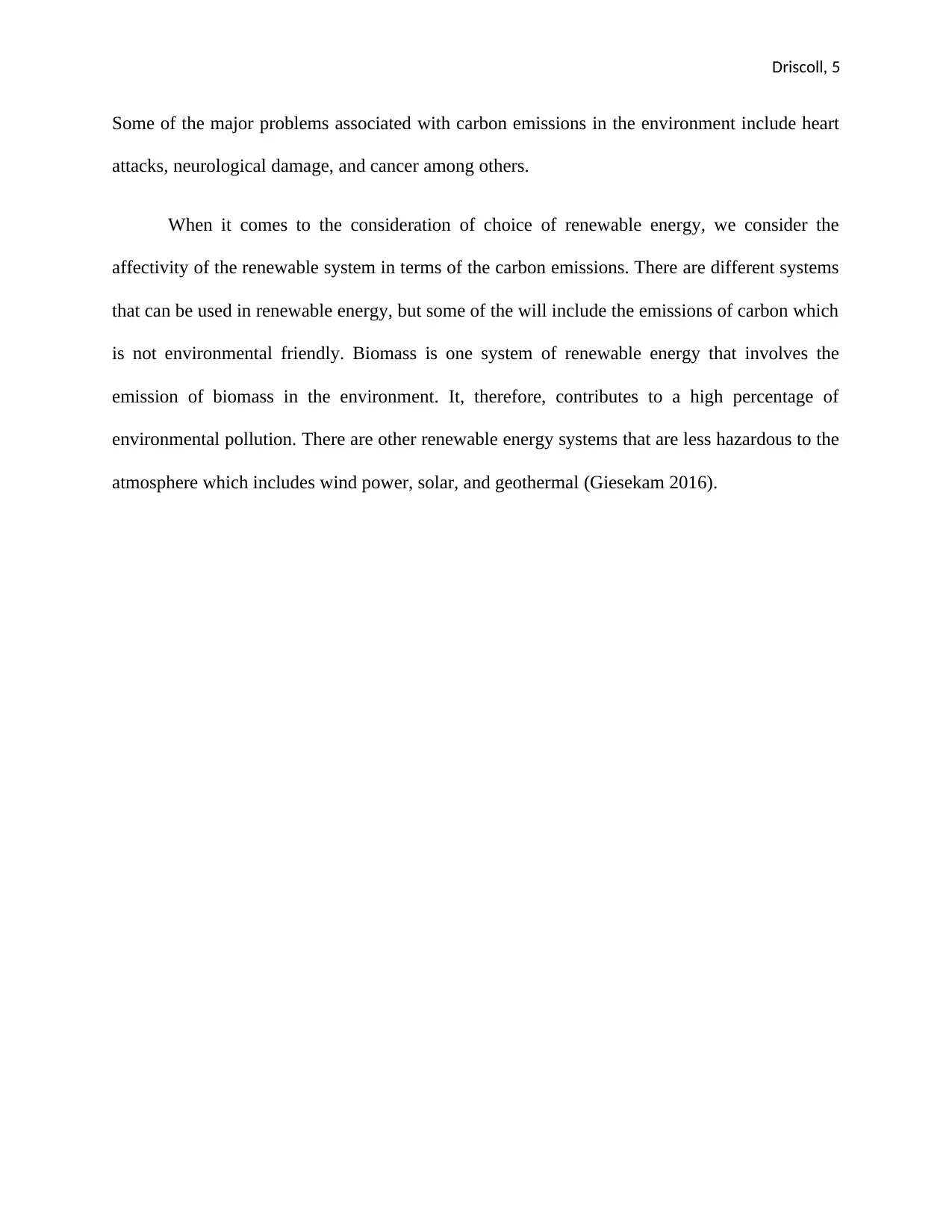
Driscoll, 5
Some of the major problems associated with carbon emissions in the environment include heart
attacks, neurological damage, and cancer among others.
When it comes to the consideration of choice of renewable energy, we consider the
affectivity of the renewable system in terms of the carbon emissions. There are different systems
that can be used in renewable energy, but some of the will include the emissions of carbon which
is not environmental friendly. Biomass is one system of renewable energy that involves the
emission of biomass in the environment. It, therefore, contributes to a high percentage of
environmental pollution. There are other renewable energy systems that are less hazardous to the
atmosphere which includes wind power, solar, and geothermal (Giesekam 2016).
Some of the major problems associated with carbon emissions in the environment include heart
attacks, neurological damage, and cancer among others.
When it comes to the consideration of choice of renewable energy, we consider the
affectivity of the renewable system in terms of the carbon emissions. There are different systems
that can be used in renewable energy, but some of the will include the emissions of carbon which
is not environmental friendly. Biomass is one system of renewable energy that involves the
emission of biomass in the environment. It, therefore, contributes to a high percentage of
environmental pollution. There are other renewable energy systems that are less hazardous to the
atmosphere which includes wind power, solar, and geothermal (Giesekam 2016).
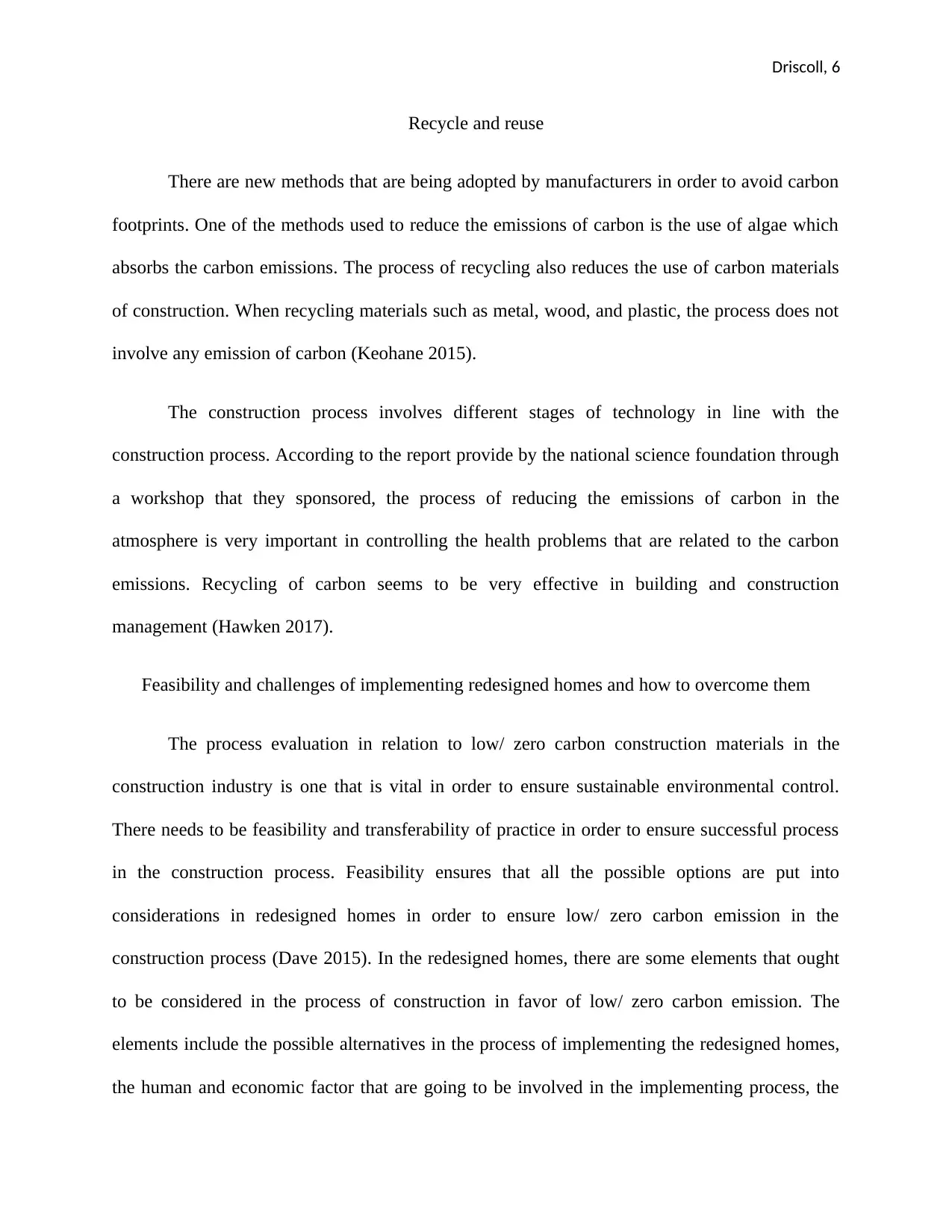
Driscoll, 6
Recycle and reuse
There are new methods that are being adopted by manufacturers in order to avoid carbon
footprints. One of the methods used to reduce the emissions of carbon is the use of algae which
absorbs the carbon emissions. The process of recycling also reduces the use of carbon materials
of construction. When recycling materials such as metal, wood, and plastic, the process does not
involve any emission of carbon (Keohane 2015).
The construction process involves different stages of technology in line with the
construction process. According to the report provide by the national science foundation through
a workshop that they sponsored, the process of reducing the emissions of carbon in the
atmosphere is very important in controlling the health problems that are related to the carbon
emissions. Recycling of carbon seems to be very effective in building and construction
management (Hawken 2017).
Feasibility and challenges of implementing redesigned homes and how to overcome them
The process evaluation in relation to low/ zero carbon construction materials in the
construction industry is one that is vital in order to ensure sustainable environmental control.
There needs to be feasibility and transferability of practice in order to ensure successful process
in the construction process. Feasibility ensures that all the possible options are put into
considerations in redesigned homes in order to ensure low/ zero carbon emission in the
construction process (Dave 2015). In the redesigned homes, there are some elements that ought
to be considered in the process of construction in favor of low/ zero carbon emission. The
elements include the possible alternatives in the process of implementing the redesigned homes,
the human and economic factor that are going to be involved in the implementing process, the
Recycle and reuse
There are new methods that are being adopted by manufacturers in order to avoid carbon
footprints. One of the methods used to reduce the emissions of carbon is the use of algae which
absorbs the carbon emissions. The process of recycling also reduces the use of carbon materials
of construction. When recycling materials such as metal, wood, and plastic, the process does not
involve any emission of carbon (Keohane 2015).
The construction process involves different stages of technology in line with the
construction process. According to the report provide by the national science foundation through
a workshop that they sponsored, the process of reducing the emissions of carbon in the
atmosphere is very important in controlling the health problems that are related to the carbon
emissions. Recycling of carbon seems to be very effective in building and construction
management (Hawken 2017).
Feasibility and challenges of implementing redesigned homes and how to overcome them
The process evaluation in relation to low/ zero carbon construction materials in the
construction industry is one that is vital in order to ensure sustainable environmental control.
There needs to be feasibility and transferability of practice in order to ensure successful process
in the construction process. Feasibility ensures that all the possible options are put into
considerations in redesigned homes in order to ensure low/ zero carbon emission in the
construction process (Dave 2015). In the redesigned homes, there are some elements that ought
to be considered in the process of construction in favor of low/ zero carbon emission. The
elements include the possible alternatives in the process of implementing the redesigned homes,
the human and economic factor that are going to be involved in the implementing process, the
⊘ This is a preview!⊘
Do you want full access?
Subscribe today to unlock all pages.

Trusted by 1+ million students worldwide
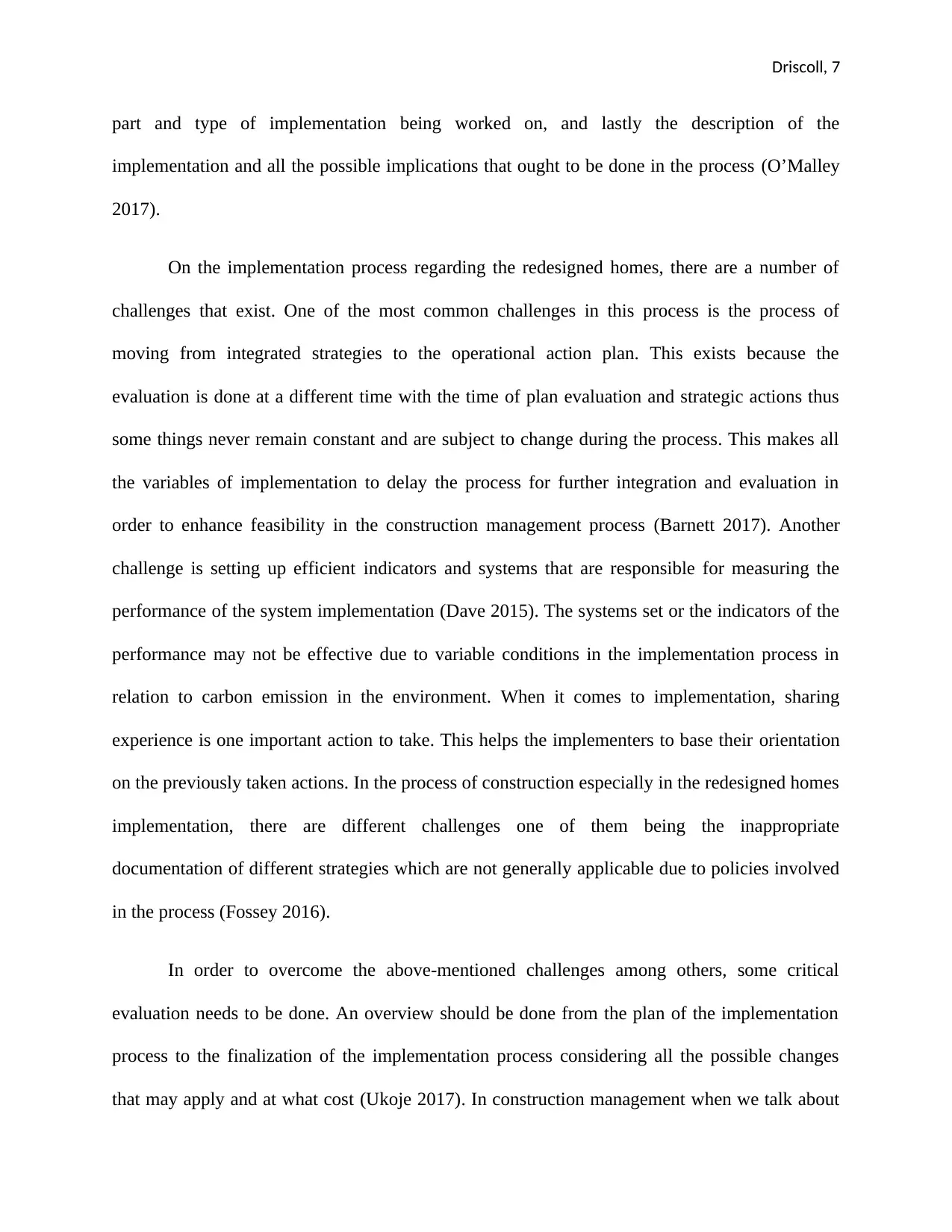
Driscoll, 7
part and type of implementation being worked on, and lastly the description of the
implementation and all the possible implications that ought to be done in the process (O’Malley
2017).
On the implementation process regarding the redesigned homes, there are a number of
challenges that exist. One of the most common challenges in this process is the process of
moving from integrated strategies to the operational action plan. This exists because the
evaluation is done at a different time with the time of plan evaluation and strategic actions thus
some things never remain constant and are subject to change during the process. This makes all
the variables of implementation to delay the process for further integration and evaluation in
order to enhance feasibility in the construction management process (Barnett 2017). Another
challenge is setting up efficient indicators and systems that are responsible for measuring the
performance of the system implementation (Dave 2015). The systems set or the indicators of the
performance may not be effective due to variable conditions in the implementation process in
relation to carbon emission in the environment. When it comes to implementation, sharing
experience is one important action to take. This helps the implementers to base their orientation
on the previously taken actions. In the process of construction especially in the redesigned homes
implementation, there are different challenges one of them being the inappropriate
documentation of different strategies which are not generally applicable due to policies involved
in the process (Fossey 2016).
In order to overcome the above-mentioned challenges among others, some critical
evaluation needs to be done. An overview should be done from the plan of the implementation
process to the finalization of the implementation process considering all the possible changes
that may apply and at what cost (Ukoje 2017). In construction management when we talk about
part and type of implementation being worked on, and lastly the description of the
implementation and all the possible implications that ought to be done in the process (O’Malley
2017).
On the implementation process regarding the redesigned homes, there are a number of
challenges that exist. One of the most common challenges in this process is the process of
moving from integrated strategies to the operational action plan. This exists because the
evaluation is done at a different time with the time of plan evaluation and strategic actions thus
some things never remain constant and are subject to change during the process. This makes all
the variables of implementation to delay the process for further integration and evaluation in
order to enhance feasibility in the construction management process (Barnett 2017). Another
challenge is setting up efficient indicators and systems that are responsible for measuring the
performance of the system implementation (Dave 2015). The systems set or the indicators of the
performance may not be effective due to variable conditions in the implementation process in
relation to carbon emission in the environment. When it comes to implementation, sharing
experience is one important action to take. This helps the implementers to base their orientation
on the previously taken actions. In the process of construction especially in the redesigned homes
implementation, there are different challenges one of them being the inappropriate
documentation of different strategies which are not generally applicable due to policies involved
in the process (Fossey 2016).
In order to overcome the above-mentioned challenges among others, some critical
evaluation needs to be done. An overview should be done from the plan of the implementation
process to the finalization of the implementation process considering all the possible changes
that may apply and at what cost (Ukoje 2017). In construction management when we talk about
Paraphrase This Document
Need a fresh take? Get an instant paraphrase of this document with our AI Paraphraser

Driscoll, 8
cost, we not only refer to the cost involved in making the process successful as a monetary cost
but also as an environmental cost which in this case we consider to be the emission of carbon. In
order to make the implementation process of the redesigned homes, there needs to be an
overview of the process of implementation. On the other hand, the need for change management
should not be underestimated at any cost (Ciribini 2016).
cost, we not only refer to the cost involved in making the process successful as a monetary cost
but also as an environmental cost which in this case we consider to be the emission of carbon. In
order to make the implementation process of the redesigned homes, there needs to be an
overview of the process of implementation. On the other hand, the need for change management
should not be underestimated at any cost (Ciribini 2016).
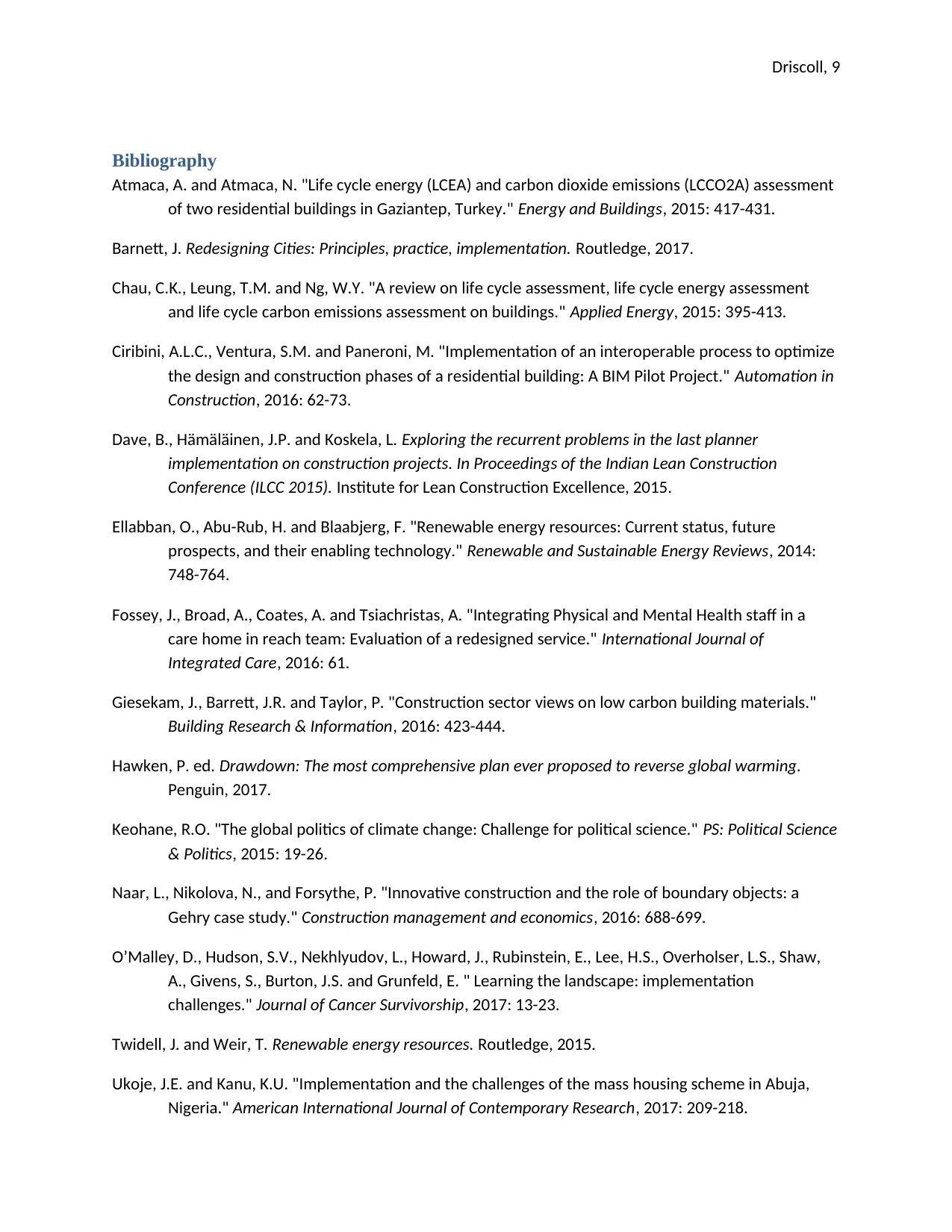
Driscoll, 9
Bibliography
Atmaca, A. and Atmaca, N. "Life cycle energy (LCEA) and carbon dioxide emissions (LCCO2A) assessment
of two residential buildings in Gaziantep, Turkey." Energy and Buildings, 2015: 417-431.
Barnett, J. Redesigning Cities: Principles, practice, implementation. Routledge, 2017.
Chau, C.K., Leung, T.M. and Ng, W.Y. "A review on life cycle assessment, life cycle energy assessment
and life cycle carbon emissions assessment on buildings." Applied Energy, 2015: 395-413.
Ciribini, A.L.C., Ventura, S.M. and Paneroni, M. "Implementation of an interoperable process to optimize
the design and construction phases of a residential building: A BIM Pilot Project." Automation in
Construction, 2016: 62-73.
Dave, B., Hämäläinen, J.P. and Koskela, L. Exploring the recurrent problems in the last planner
implementation on construction projects. In Proceedings of the Indian Lean Construction
Conference (ILCC 2015). Institute for Lean Construction Excellence, 2015.
Ellabban, O., Abu-Rub, H. and Blaabjerg, F. "Renewable energy resources: Current status, future
prospects, and their enabling technology." Renewable and Sustainable Energy Reviews, 2014:
748-764.
Fossey, J., Broad, A., Coates, A. and Tsiachristas, A. "Integrating Physical and Mental Health staff in a
care home in reach team: Evaluation of a redesigned service." International Journal of
Integrated Care, 2016: 61.
Giesekam, J., Barrett, J.R. and Taylor, P. "Construction sector views on low carbon building materials."
Building Research & Information, 2016: 423-444.
Hawken, P. ed. Drawdown: The most comprehensive plan ever proposed to reverse global warming.
Penguin, 2017.
Keohane, R.O. "The global politics of climate change: Challenge for political science." PS: Political Science
& Politics, 2015: 19-26.
Naar, L., Nikolova, N., and Forsythe, P. "Innovative construction and the role of boundary objects: a
Gehry case study." Construction management and economics, 2016: 688-699.
O’Malley, D., Hudson, S.V., Nekhlyudov, L., Howard, J., Rubinstein, E., Lee, H.S., Overholser, L.S., Shaw,
A., Givens, S., Burton, J.S. and Grunfeld, E. " Learning the landscape: implementation
challenges." Journal of Cancer Survivorship, 2017: 13-23.
Twidell, J. and Weir, T. Renewable energy resources. Routledge, 2015.
Ukoje, J.E. and Kanu, K.U. "Implementation and the challenges of the mass housing scheme in Abuja,
Nigeria." American International Journal of Contemporary Research, 2017: 209-218.
Bibliography
Atmaca, A. and Atmaca, N. "Life cycle energy (LCEA) and carbon dioxide emissions (LCCO2A) assessment
of two residential buildings in Gaziantep, Turkey." Energy and Buildings, 2015: 417-431.
Barnett, J. Redesigning Cities: Principles, practice, implementation. Routledge, 2017.
Chau, C.K., Leung, T.M. and Ng, W.Y. "A review on life cycle assessment, life cycle energy assessment
and life cycle carbon emissions assessment on buildings." Applied Energy, 2015: 395-413.
Ciribini, A.L.C., Ventura, S.M. and Paneroni, M. "Implementation of an interoperable process to optimize
the design and construction phases of a residential building: A BIM Pilot Project." Automation in
Construction, 2016: 62-73.
Dave, B., Hämäläinen, J.P. and Koskela, L. Exploring the recurrent problems in the last planner
implementation on construction projects. In Proceedings of the Indian Lean Construction
Conference (ILCC 2015). Institute for Lean Construction Excellence, 2015.
Ellabban, O., Abu-Rub, H. and Blaabjerg, F. "Renewable energy resources: Current status, future
prospects, and their enabling technology." Renewable and Sustainable Energy Reviews, 2014:
748-764.
Fossey, J., Broad, A., Coates, A. and Tsiachristas, A. "Integrating Physical and Mental Health staff in a
care home in reach team: Evaluation of a redesigned service." International Journal of
Integrated Care, 2016: 61.
Giesekam, J., Barrett, J.R. and Taylor, P. "Construction sector views on low carbon building materials."
Building Research & Information, 2016: 423-444.
Hawken, P. ed. Drawdown: The most comprehensive plan ever proposed to reverse global warming.
Penguin, 2017.
Keohane, R.O. "The global politics of climate change: Challenge for political science." PS: Political Science
& Politics, 2015: 19-26.
Naar, L., Nikolova, N., and Forsythe, P. "Innovative construction and the role of boundary objects: a
Gehry case study." Construction management and economics, 2016: 688-699.
O’Malley, D., Hudson, S.V., Nekhlyudov, L., Howard, J., Rubinstein, E., Lee, H.S., Overholser, L.S., Shaw,
A., Givens, S., Burton, J.S. and Grunfeld, E. " Learning the landscape: implementation
challenges." Journal of Cancer Survivorship, 2017: 13-23.
Twidell, J. and Weir, T. Renewable energy resources. Routledge, 2015.
Ukoje, J.E. and Kanu, K.U. "Implementation and the challenges of the mass housing scheme in Abuja,
Nigeria." American International Journal of Contemporary Research, 2017: 209-218.
⊘ This is a preview!⊘
Do you want full access?
Subscribe today to unlock all pages.

Trusted by 1+ million students worldwide

Driscoll, 10
Zhang, X., Ji, W., Qi, Y., Li, L. and Shi, M. Innovative Methods of Strengthening the Construction Quality of
Mechanical and Electrical Engineering. Smart Construction Research, 2018.
Zhou, Z., He, C., Xiu, J., Yang, L. and Duan, C. "Metalorganic polymers containing discrete single-walled
nanotube as a heterogeneous catalyst for the cycloaddition of carbon dioxide to epoxides."
Journal of the American Chemical Society, 2015: 137.
Zhang, X., Ji, W., Qi, Y., Li, L. and Shi, M. Innovative Methods of Strengthening the Construction Quality of
Mechanical and Electrical Engineering. Smart Construction Research, 2018.
Zhou, Z., He, C., Xiu, J., Yang, L. and Duan, C. "Metalorganic polymers containing discrete single-walled
nanotube as a heterogeneous catalyst for the cycloaddition of carbon dioxide to epoxides."
Journal of the American Chemical Society, 2015: 137.
1 out of 10
Related Documents
Your All-in-One AI-Powered Toolkit for Academic Success.
+13062052269
info@desklib.com
Available 24*7 on WhatsApp / Email
![[object Object]](/_next/static/media/star-bottom.7253800d.svg)
Unlock your academic potential
Copyright © 2020–2025 A2Z Services. All Rights Reserved. Developed and managed by ZUCOL.




